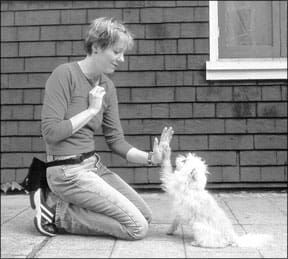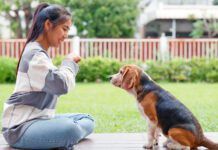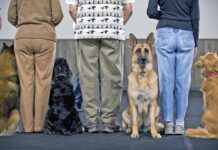Does your dog know how to target? If not, the two of you may be missing out on one of the most versatile behaviors to come along since the rise in popularity of the positive dog training philosophy.
Targeting simply means teaching your dog to touch a designated body part to a designated spot the end of a commercially produced target stick, your hand, an object, a location, or anything at all. While much targeting is done with the dog’s nose as the designated body part, you can actually teach your dog to touch with a front or hind foot, his hip, shoulder, ear, or any other moveable piece of his anatomy.
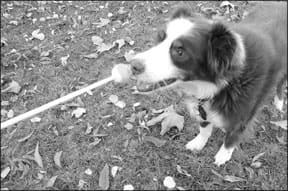
288
We teach nose targeting in my Basic Adult and Puppy classes. Whenever I introduce the exercise to a new group I get puzzled stares from most of the humans in the class. I can just see them thinking, “Why on earth would I want to teach my dog to do that?!” proof that the concept of targeting still has miles to go before gaining familiarity and acceptance in the mainstream pet dog community.
The list of reasons why you want to teach your dog to touch is as long as your arm, and then some. From the serious to the sublime, targeting is useful and fun for canines and humans alike. You can use targeting to teach good manners and dog behaviors such as “Go to your place” and to help your dog learn polite leash walking. “Touch the target” can be used as an emergency recall, or your dog’s cue to ask to go outside.
It also has widespread application for a number of service dog behaviors, can be used to teach agility dogs to hit the contact zones, and give search dogs a tool to communicate that they’ve located sign of the missing person (or pet). Finally, targeting can come into play with an endless variety of entertaining tricks and games. There’s something for everyone.
Getting Ready
It’s almost imperative that you use a reward marker the click! of a clicker or some other quick, sharp sound or word for fast and effective target training. The “touch” behavior happens so quickly that it’s difficult for the dog to understand what he’s being reinforced for absent a conditioned sound that marks the instant of rewardable behavior. If you have not already done so, start by “charging” your clicker teaching your dog that “click!” (or whatever sound you choose to use) means he just earned a reward. Note: If you want to use a verbal marker instead of a clicker, I suggest not using the word “Good.” We frequently tell our dogs they’re good dogs just because we love them. Your reward marker needs to have a very specific meaning: “That behavior just earned a treat!” You don’t want to have to feed your dog a treat every time you tell him he’s a good dog! I suggest using the word “Yes!” or even the word “Click!” as verbal markers.
Charging the clicker is one of the easiest things you’ll ever teach your dog. It’s classic Pavlov (classical conditioning) simply giving the dog a strong positive association between the click or other marker and yummy food. So, assuming you use a clicker, just “click!” it a half-dozen to a dozen times, following each click with a tasty treat, and you will soon be good to go. To test if the clicker is “charged,” wait for your dog to look away and click the clicker once. His head should swivel back to you in anticipation of the treat. If it doesn’t, supply yourself with treats that are more irresistible, and click and treat a few more times.
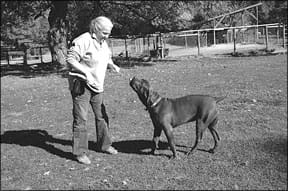
288
A small percentage of dogs are afraid of the sound of the clicker. When you first introduce it, click it inside a pocket to muffle the sound a bit. If at any time you notice an adverse reaction to the clicker from your dog, charge and use a verbal marker instead.
Basic nose targeting
The easiest body part to start with is the nose or a front paw, since dogs use those two body parts almost exclusively to explore their world. My preference is nose targeting the one we teach in our beginner classes because it’s easy to elicit the behavior, and doesn’t reinforce dogs who might already be a little too free with the use of their paws. Foot is my second choice for an easy and useful targeting behavior.
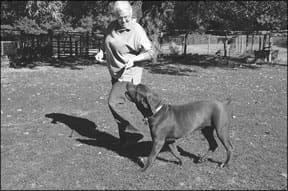
288
You can capture targeting to your hand, which means getting the complete “touch” behavior, clicking and treating when he does or you can shape it which means clicking and treating for “successive approximations” of moving his nose closer and closer to your hand. (See “The Shape of Things to Come,” Whole Dog Journal March 2006, for more information about shaping.)
Dogs tend to naturally sniff an offered hand, so to “capture” a touch, offer your open palm to your dog at nose level with your fingers pointing toward the ground. If your dog thinks this is an invitation to “Shake,” offer your closed fist instead.
When he sniffs your offered hand, mark the desired behavior with the click! of a clicker (or verbal marker, such as “Yes!”) and give the dog a treat. Repeat until you see him deliberately bump his nose into your hand because he’s figured out he can make you click and treat by touching you. Then add your verbal cue (for example, “Touch!”) just before his nose touches. In short order you’ll be able to prompt him to target to your hand.
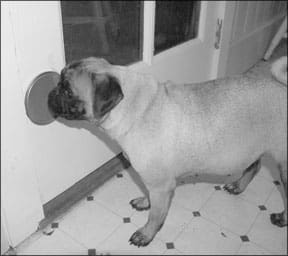
288
Of course, it’s not always quite that easy. Your dog may sniff the hand a few times and then stop, either because your hand is no longer interesting to him, or because he’s just focusing on the source of the treats. If he needs a jump start, rub something tasty on your hand and offer it for a sniff or a lick. You’re on your way!
Once you’ve established the targeting behavior to your hand, you can transfer it to another object. Hold the target object in your hand, cue the behavior, and give him a click and treat when he touches the target. Fade the presence of your hand by moving it away from the target object until he’ll touch it by itself.
Practice targeting to enough different objects, and your dog will happily touch any object you indicate, the first time you ask. You can even name several objects and teach him to touch different ones on cue, a behavior called target discrimination.
Any time you want to add a new cue for a behavior, use the new cue, followed by the old one. When you name an object, you’re really just giving that specific object a new cue.
For example, if you set a gallon water jug on the floor and say “Touch!” your dog touches it. Now say “Jug, touch!” After enough repetitions (“enough” will vary, depending on the dog and how touch-savvy he is), you can drop the “Touch” cue and just say “Jug!” to get your dog to touch the water bottle.
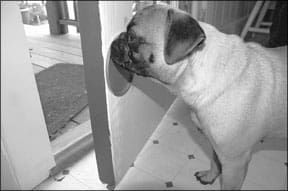
288
Applied Targeting
Ready to start making use of your dog’s new behavior? Try these: ¡ Polite leash walking. This is one of the most useful applications of targeting. When your dog starts to lag or move too far ahead of you, position your target hand or the end of the target stick where you’d like the dog to be (traditionally at your left side) and ask him to “Touch!” Click and treat when he’s in position.
To keep him there, give your “Touch” cue more frequently, and reinforce randomly very frequently at first, then less so as he gets better at polite walking. If you have a small dog and don’t want to bend over for him to touch your hand, teach him to touch a target stick and offer that as you walk, instead.
Close a door/drawer. Teach your dog to target to a plastic disk (like a cottage cheese container lid) in your hand. Then stick the lid to a cupboard door or drawer with rubber glue or double-sided tape at your dog’s nose level, and ask him to touch it there.
You may need to have your hand near the lid at first, and fade the presence of your hand or not, if your dog is really adept at targeting. When he’ll consistently touch the lid on cue, shape for harder touches by only clicking the ones that move the door, at least a little. Eventually he’ll close the door all the way.
If you don’t want a plastic lid on your cupboard forever, fade its presence by cutting it into increasingly smaller circles, until there’s no lid left and your dog has transferred the “touch” to the door itself.
Turn on/off a lamp. Gotta love those touch on/touch off lamps; they’re perfect for target training! Show your dog the lamp and ask him to “Touch!” If your dog still needs some assistance, put your hand behind the lamp to help him touch it and gradually fade the presence of your hand.
Be careful with this one! I had a friend whose husband accused her of not leaving the light on when she went to bed before he did until they realized their Sheltie was turning off the light after her mistress fell asleep.
Go to your place. Get out another cottage cheese lid (since you cut up the last one) and stick it where you want your dog’s “place” to be. Ask him to target to the lid from increasing distances, until you can send him to his spot from across the room, and eventually even from another room.
When he’s targeting to his spot easily, start asking him to lie down when he gets there. Then change his cue for the behavior to “Place!” –or whatever cue you prefer by using the new cue first, followed by the old cue, or “Place Touch!” Eventually you can drop the “touch” and he’ll go to his spot and lie down when you say “Place!”
You can teach him that one particular place is his spot, or you can generalize the behavior and teach him that anywhere you stick a cottage cheese lid is his spot.
Play ball. Teach your dog to push a large ball with his nose one he can’t pick up in his mouth. The hard plastic Jolly Ball is perfect for this, and comes in a variety of sizes from small to very large. When he’s learned this one you can sit on the floor across from him and the two of you can roll the ball back and forth a great game to play when your dog needs exercise and it’s too cold or stormy to go outside. This behavior can also turn your dog into a great babysitter as long as you remember that dogs and small children must always be under direct adult supervision.
Be brave. This is another application of classical conditioning helping your dog develop an association between two different things. Most dogs love targeting once they’ve learned it. What’s not to love? You’re like a treat vending machine your dog pushes the button (your hand), he gets a treat. He pushes the button, he gets a treat. As a result, he has a very positive association a “Yay!!” feeling when you ask him to touch.
Now, say you’re walking down the street with your dog on leash and you have to a garbage collection truck. As you approach, the worker drops a metal garbage can, sending it clattering across the sidewalk 25 feet in front of you. Your dog happens to be a little fearful of loud noises and is now afraid to walk past the can, even though the garbage truck is long gone.
You offer your hand and ask your dog to touch. His brain goes “Yay! Targeting!” and he takes a step forward to touch your hand. You target him past the garbage can, and since he can’t be happy about targeting and afraid of the can at the same time, and because his association with targeting is so positive, not only do you get him past the can, but the positive association has rubbed off and now he thinks garbage cans are pretty cool, too.
Paw Targeting
Some behaviors work better as paw targets than nose targets, especially things that require a little more “oomph” behind the touch turning appliances on and off, for example. Others work equally well either way, and if you teach you dog both, you can choose which one to ask for.
For dogs who are naturally “pawsy,” paw targeting is a breeze. Put something on the floor, and when your dog paws at it, click and treat. When he’s pawing at it reliably, add a verbal cue. Be sure to use a different cue from the one you use for his nose! I use “Foot!” to ask my dogs to target with a paw, “Touch!” for the nose.
If your dog’s not a paw-natural, you can “shape” a foot touch. Start by clicking any movement of one paw while your dog stands or sits in front of you. Pick just one paw or you could end up shaping a tap dance! At first you might just get tiny paw movements, but when your dog figures out what you’re clicking for, his paw movements will become more deliberate and more expansive.

288
When he’s doing significant paw movement, add your “Foot” cue, then place an object on the floor. At first click if his paw lands anywhere near the object, then eventually only if it actually touches the object. Finally, add a new cue for the specific object you’re asking him to touch with his paw. Some paw-touch applications include:
Playing soccer. You already taught him to push a ball with his nose. Now use a different cue for paw-soccer, and you’ve got another good energy-eating game.
Playing a keyboard. This is a great crowd-pleaser for my Scottie, Dubhy; he sits up on a chair and plays an electronic keyboard with his paws. He actually started with a nose-touch on a plastic kiddie piano and graduated to the keyboard.
Five more minutes. Pushing the snooze button on the alarm an obvious application, but don’t let him make you late for work!
Go to your place. Instead of a lid on the wall, teach him to target with his paws to a rug or mat on the floor.
Turning off the TV remote. For an additional challenge, teach him to do this only after you fall asleep watching TV!
Some of my favorite targeting applications are just for fun. At shaping camp we teach our dogs to turn on a smiley-face push light because it’s cute. One of my clients went one better, however. Matt Conaty discovered a great target object at a chain office supply store a push-button gadget. Now when his Jack Russell Terrier, Bally, pushes the button, a recorded voice says “That was easy!” Indeed it was. And fun, too!
Pat Miller, CPDT, is Whole Dog Journal’s Training Editor.Miller lives in Hagerstown, Maryland, siteof her Peaceable Paws training center. Sheis also the author of The Power of Positive Dog Training and Positive Perspectives:Love Your Dog, Train Your Dog.


